VI.
PLANT COMMUNITIES
A. CHAPPARAL
Chaparral
communities are found on several continents - in the
Mediterranean, the African Cape region, central Chile,
and southwestern Australia. In California, chaparral
communities occur between 200 and 5000 ft. elevation
and cover about ten million acres. Although their
species composition varies from continent to continent,
there are certain characteristics which are universal.
The term "chaparral" derives from the Spanish chaparro,
which is a thicket of shrubby evergreen oaks or a
low-growing type of vegetation. In some references,
particularly older ones referring more specifically
to the chaparral communities of southern California,
chaparral is referred to as "hard chaparral" (vs.
"soft chaparral" or coastal scrub). Some references
use "brushlands" for both chaparral and coastal scrub.
In other documents, chaparral is a broad classification
within which there are as many as 28 types such as
chamise chaparral or "chamisal," mesic serpentinite
chaparral, mesic north slope chaparral, scrub oak
chaparral, coastal sage - chaparral scrub, and poison-oak
chaparral.
Chaparral
vegetation is typically an impenetrable entanglement
of mostly four- to twelve-foot tall evergreen woody
shrubs and/or dwarf trees. There is rarely much of
an understory save an occasional soap plant (Chlorogalum
pomeridianum) or melic grass (Melica spp.).
A chaparral community is composed mainly of species
which are adapted to seasonal and periodic drought
by having sclerophylls (hardened leaves). Some of
these sclerophyllous plants have reduced, needle-like
leaves, e.g., chamise (Adenostoma fasciculatum),
others have larger ones, e.g., manzanita (Arctostaphylos
spp.). Some of the plants lose their leaves during
prolonged droughts. Although many species may be dominant
in chaparral communities, very few associated or understory
species are found. Absent also are seedlings of those
chaparral species already represented. This may be
because many of the dominant species have high concentrations
of compounds in their foliage which function as allelopathogens,
phytotoxins that effectively suppress the germination
and/or growth of other plants, thereby eliminating
competition for water and nutrients. The dominant
species are mostly spring-active, in other words they
photosynthesize and grow in the spring, when rains
have been able to penetrate deeply enough into the
soil to become available to their roots. Under arid
conditions, chaparral plants produce more fine roots
than leaves and, although the plants may be evergreen,
the fine roots are shed yearly in the hot, dry season.
These species tend to be dormant in the summer.
Chaparral
plants are highly adapted to periodic natural fires
which occur once every ten to thirty or more years.
Recent studies suggest that the role of fire in these
communities may be of recent origin, shaping them
beyond the effects of the Mediterranean climate. Some
studies suggest that fire can benefit the chaparral
community. The older the chaparral, the more monotypic
(single-species) and fragile it becomes. As long as
fire does not occur too frequently, it has the potential
to rejuvenate chaparral by encouraging the growth
of numerous species which might have been excluded
in the years immediately preceding the fire.
One
of several fire adaptations of chaparral plants is
their ability to produce seeds at an early age. This
occurs in some species of manzanita (Arctostaphylos)
and buckbrush (Ceanothus) that do not resprout
from woody plant parts.
Another
fire adaptation is seed dimorphism: some chaparral
plants produce two types of seeds, one that germinates
under "normal" conditions and one which requires scarification,
or the heat of a fire, in order to germinate. The
latter seed type is called a "refractory" or "resistant"
seed. It may remain viable for decades. Both chamise
(Adenostoma fasciculatum) and deerweed (Lotus
scoparius) produce two types of seeds. Recent
studies suggest that charcoal residues in the soil
are more influential on seed germination than heat
alone.
Fire
reduces the levels of organic nitrogen in the soil,
but makes what nitrogen is present more available
to plants. Many leguminous plants (pea family) and
Ceanothus spp. have nodules on their roots
which use nitrogen extracted from the atmosphere and
fix it, that is they are able use it for their physiological
processes as well as increase its levels in the soil
around them. However, for approximately five years
after fires the productivity of these plants is reduced.
Another
fire adaptation found in some chaparral plants, such
as some species of manzanita (Arctostaphylos)
and chamise (Adenostoma fasciculatum), is their
ability to sprout after a fire from underground woody
plant structures called lignotubers (woody tap-roots),
basal burls, or root-crown burls. These structures
have vegetative buds located several inches below
the soil surface which remain dormant until the winter
rains following a fire. Also able to survive fire
are western poison oak (Toxicodendron diversilobum)
which has extensive underground rhizomes, and wild
cucumber vine (Marah fabaceus) which has a
huge fleshy root deep under the soil surface.
When
chaparral areas are prevented from undergoing cyclical
burns, so much biomass accumulates that the intensity
of the inevitable fire can be sufficiently extreme
to destroy the subsurface plant structures (seeds
and/or buds on lignotubers and root-crown burls).
Thus, the natural pattern of succession is broken.
To avoid the problems associated with this, some biologists
recommend burning chaparral areas at least once every
twenty years. However, this is somewhat controversial.
If a site is burned too frequently, it may be transformed
into a specific type of chaparral called chamisal
- a chaparral whose main component is chamise (Adenostoma
fasciculatum). Alternatively, it may even fail
to regenerate at all as chaparral. A burned chaparral
stand may be transformed into a coastal scrub or a
grassland composed mostly of annual non-native species.
Disturbance,
by fire or otherwise, in chaparral is often made evident
by the presence of invasive coastal scrub species
such as black sage (Salvia mellifera), a prominent
shrub in both the coastal scrub and chaparral of Poly
Canyon. Other early successional species are deerweed
(Lotus scoparius) and, especially in steep,
rocky areas, sticky monkeyflower (Mimulus aurantiacus).
Some
chaparral-dominated areas in Poly Canyon occur on
serpentinite and the soils derived from it. The ecology
of such areas is more fully discussed above, in the
geology and soils section, and below, in the section
on serpentinite communities. Serpentinite tolerant
species found in chaparral communities in Poly Canyon
include chamise (Adenostoma fasciculatum),
toyon (Heteromeles arbutifolia), and buckbrush (Ceanothus
cuneatus). Serpentinite endemic species include
Obispo manzanita (Arctostaphylos obispoensis),
leather oak (Quercus durata), and a species
planted in the Botanic Garden in Poly Canyon, but
native on Cuesta Ridge a few miles away, Sargent cypress
(Cupressus sargentii).
In
Poly Canyon, chaparral is most often found on the
uppermost slopes and hilltops. It is bordered by grasslands,
coastal live oak woodland, coastal scrub, rock outcrops,
and anthropogenic communities. It is often tightly
intertwined with coastal scrub, forming a complex
patchwork on many of the hillsides.
- Dominant
plants of the chaparral include:
- Chamise,
greasewood (Adenostoma fasciculatum, Rosaceae)
- Buckbrush,
California lilac(Caenothus cuneatus, Rhamnaceae)
- Birch-leaf
mountain mahogany (cercocarpus betuloides,
Rosaceae)
- Flannelbush,
Fremontia (Fremontodendron californicum ssp.
californicum , Sterculiaceae)
- *Toyon,
Christmas berry (Heteromeles arbutifolia,
Rosaceae)
- Islay,
holly-leafed cherry (Prunus ilicifolia, Rosaceae)
- *Leather
oak (Quercus durata, Fagaceae)
- *California
coffeeberry (Rhamnus californica, Rhamnaceae)
- *Spiny
redberry, Buckthorn (Rhamnus crocea, Rhamnaceae)
- *Black
Sage (Salvia mellifera, Lamiaceae)
- *Western
poison oak (Toxicodendron diversilobum, Anacardiaceae)
- Associate
species include:
- Soap
plant, amole (Chlorogalum pomeridianum, Liliaceae)
- Prickly,
Phlox-leafed bedstraw (Galium andrewsii,
Rubiaceae)
- *Climbing
bedstraw (Galium porrigens, Rubiaceae)
- *California
peony (Paeonia californica, Paeoniaceae)
-
-
-
-
Descriptions
of Poly Canyon's chaparral plants follow.
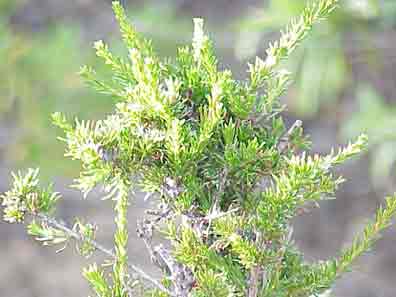
Chamise,
greasewood (Adenostoma fasciculatum,
Rosaceae) This is an evergreen shrub that
grows to 4 m. (12 feet) tall. Chamise has
4- to 10-mm. (1/8-to 1/2-inch) needle-like
leaves in fascicles. Its tiny creamy white
flowers are found in 4- to 12-cm. (11/2- to
5-inch) clusters at the tips of branches.
Chamise blooms from May through July. Its
fruit is an achene. It is indifferent to serpentinitic
soils and is found primarily in chaparral
communities and on dry slopes and ridges.
Adenostoma
comes from the Greek aden meaning "a
gland" and stoma "mouth," referring
to the five glands at the mouth of the sepals.
Fasciculatum refers to the arrangement
of the leaves in bundles calles "fascicles."
The
hard wood of chamiso has been used
by Chumash in the manufacture of various tools.
The leaves were made into tea for childbirth
or menstrual complications.
|
|

Charles Webber
Buckbrush,
California lilac (Ceanothus cuneatus,
Rhamnaceae) Buckbrush is an evergreen shrub
that grows to 3 m. (10 feet). Its 3-cm. (1/4-inch)
cuneate-obovate leaves are thick and somewhat
hard. The tiny white, pale blue, or lavender
flowers are found in dense, 21/2-cm. (1-inch),
raceme-like umbels from March through May. Its
4- to 6-mm. (1/8- to 1/4-inch) fruit is a three-horned,
thick, green-red capsule. Buck brush is indifferent
to serpentinitic soils. It occurs on dry slopes
and ridges in chaparral communities. Ceanothus
species host nitrogen-fixing bacteria.
Ceanothus
means "spiny plant." Cuneatus refers
to the wedge-like shape of the leaves.
Chumash
used the flowers for hair and body shampoo by
rubbing them with water to form a lather.
|
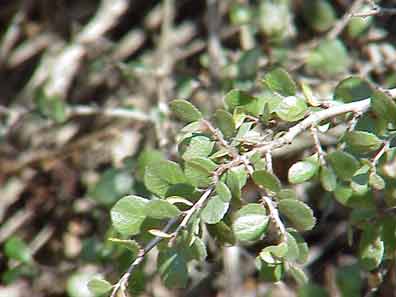
Birch-leaf
mountain-mahogany (Cercocarpus betuloides
var. betuloides, Rosaceae)
This
evergreen shrub or tree grows typically to
between 2 and 8 m. (6 and 24 feet tall). Its
1- to 5-cm. (1/2- to 2-inch) leaves are obovate
to oval shaped with margins that are finely
serrate above the middle and entire from the
middle to the base. The leaves are pinnately
veined with four to seven lateral veins. The
greenish radial flowers have an 8-mm. (1/4-inch)
apetalous, funnel-shaped hypanthium. The blooms
appear from March through April. The fruit
is a hairy, cylindric achene with the long,
plumose style still attached. Birch-leaf mountain-mahogany
is indifferent to serpentinitic soils and
is found in chaparral communities on dry,
rocky slopes.
Cercocarpus
comes from the Greek, kerkos meaning
"tail" and karpos meaning "fruit."
This refers to the tailed appearance of the
fruit to which the style remains attached.
Betuloides means "birch-like."
Palo
fiero (iron wood or stick, in Spanish)
was used by Chumash as a digging tool.
|
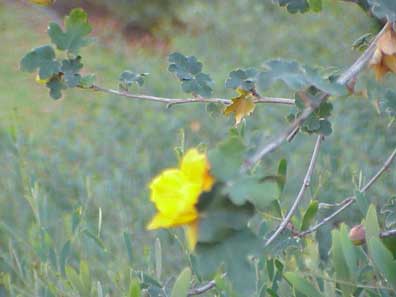
Flannelbush,
Fremontia (Fremontodendron californicum
ssp. californicum, Sterculiaceae) Flannelbush
is a 2- to 5-m. (6- to 15-foot) tall evergreen
shrub or tree. Its branches and leaves are
densely covered with stellate hairs. Its soft,
leathery leaves grow to between 1 and 5 cm.
(1/3 and 2 inches). These are ovate in shape
and palmately to pinnately lobed. The showy,
60-mm. (2-inch), radial flowers of the flannelbush
are vivid yellow and sometimes have reddish
margins. The fruit is a 2- to 4-cm. (3/4-
to 11/2-inch) bristly capsule. Kruckeberg
lists flannelbush as a serpentinite indicator.
It is found in chaparral communities.
Fremontia
means "Frémont's tree," after John C. Frémont,
a 19th century explorer in the West. Californicum
means "of California."
Flannelbush
is in the Cacao family from which we get Cola
and chocolate. The stellate hairs on its branches
can be quite irritating to human skin.
|

*Toyon,
Christmas berry (Heteromeles arbutifolia,
Rosaceae) This is an evergreen shrub or tree
that grows to 5 m. (16 feet) tall. It has
4- to 11-cm. (11/2- to 41/2-inch) leathery,
elliptic to oblong leaves that are sharply
toothed, with shiny tops and dull undersides.
Its tiny white rotate flowers occur in panicles
between June and August. Christmas berry has
5- to 10-mm. (1/4- to 1/2-inch) red berry-like
fruit (pomes) from November through January.
The timing of the fruiting makes it a very
important food source for wildlife. It occurs
in chaparral and oak woodland communities.
Heteromeles
means "different apple." Arbutifolia
refers to the similarity of the leaves to
those of the Spanish madrone or strawberry
tree, Arbutus unedo.
Toyon
derives from the Costanoan name for the plant
tottcon. Chumash used its berries for
food. Its hard wood was fashioned into a variety
of tools, used for fuel, and in rituals.
|
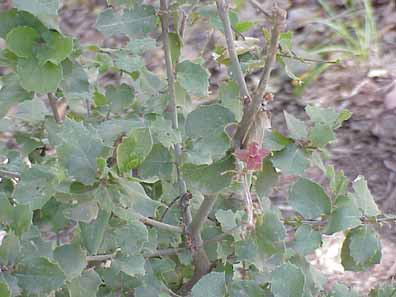
Islay,
holly-leafed cherry (Prunus ilicifolia
ssp. illicifolia, Rosaceae) Islay is
an evergreen shrub or tree that grows to 9
m. (30 feet) tall. It has 2- to 14-cm. (3/4-
to 51/2-inch) alternate, leathery, ovate,
spiny-toothed leaves. Its tiny, rotate, white
flowers cluster in dense racemes from April
through May. These are followed by 12- to
18-mm. (1/2- to 3/4-inch) purplish red drupes.
Islay is found in canyons and on slopes, in
shrubland and woodland communities. Its flowers
attract bees.
Prunus
is the ancient Latin name for "plum." Ilicifolia
means "holly-like leaves."
Islay
comes from a Salinan Indian name, "slay."
The fruit and seed were eaten by native Californians.
The seed, once leached of hydrocyanins, was
highly valued as a food. One hatfull of islay
was worth two hatfulls of acorns; two and
a half hatfuls of islay were worth one hatful
of chia.
|
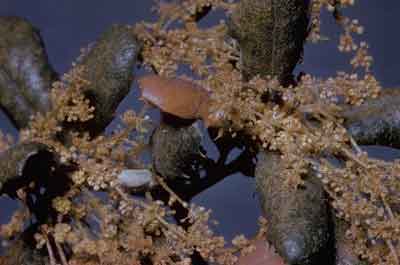
Charles Webber
*Leather
oak (Quercus durata var. durata,
Fagaceae) This evergreen shrub or tree grows
from 1 to 3 m. (3 to 10 feet) tall. It has
11/2- to 3-cm. (1/2- to 11/4-inch) spiny,
convex leaves. The leaves are hairy on both
surfaces with small, stellate hairs. Male
flowers are minute, cream-colored, and occur
in catkins. Female flowers are solitary and
axillary. They are followed by acorns which
take one year to mature. Leather oak is restricted,
for the most part, to serpentinitic soils
within chaparral communities.
Quercus
is the ancient Latin name for "oak," from
which we derive "cork," a product of some
species of oak. Quercus comes from
two Celtic words: quer "fine" and quez
"tree." Durata means "hard" in Latin
and probably refers to the hardness of the
leaves.
|

*California
coffeeberry (Rhamnus californica,
Rhamnaceae) This is an evergreen, upright
shrub that grows to 5 m. (15 feet) tall. It
has characteristically reddish twigs. Its
23- to 90-mm. (1- to 31/2-inch) leaves are
shiny, dark green on the upper surface and
a bright yellowish green on the lower surface.
They are leathery and oblong with minutely
serrate margins and prominent veins. The inconspicuous
greenish or white radial 5-merous flowers
occur in five to 60-flowered umbels nearly
year-round. The inflorescence is followed
by 10- to 15-mm. (1/4- to 1/2-inch) coffee-colored
(when immature) or black berry-like fruits
(drupes). According to The Jepson Manual,
California coffeeberry does not tolerate serpentinitic
soils. However, Kruckeberg writes that it
is indifferent to serpentinitic soils. It
occurs in chaparral, coastal scrub, and oak
woodland communities.
Rhamnus
is derived from the ancient Greek name for
"buckthorn." Californica means "of
California."
Chumash
believed the berries of "yerba del oso" (bear's
grass, in Spanish) to be toxic to humans,
but not to bears. The leaves were rubbed on
the skin to soothe rheumatism. Bathing in
a decoction of leaves was said to soothe poison
oak rash. The bark was used as a laxative.
It has occasionally been called cáscara
sagrada (Spanish for "sacred bark"), although
this name is usually given to Rhamnus purshiana.
|

*Spiny
redberry, Buckthorn (Rhamnus crocea,
Rhamnaceae) This evergreen shrub reaches to
2 m. (6 feet) tall. Its branches are thorn-tipped.
It has finely toothed 11- to 19-mm. (1/4-
to 1/2-inch) elliptic to obovate leaves. These
are shiny, leathery, and feather-veined and
often occur in fascicles. The inconspicuous
whitish to yellowish 4-merous flowers occur
in clusters of one to six between March and
April. The flowers are followed by 6-mm. (1/4-inch)
red berry-like fruits (drupes). Spiny redberry
is is indifferent to serpentinitic soils and
is found in chaparral, coastal scrub, and
woodland communities.
Rhamnus
is derived from the ancient Greek name for
"buckthorn." Crocea means "saffron-colored."
|
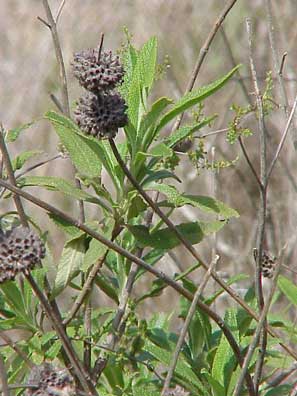
*Black
sage (Salvia mellifera, Lamiaceae)
This is a drought deciduous, 1- to 2-m. (3-
to 6-foot) shrub. Black sage has very aromatic
foliage; the odor clings to one's clothing
long after brushing up against this shrub.
The glandular leaves are 21/2 to 7 cm. (1
to 3 inches) long. Its 6- to 9-mm. (1/4- to
1/3-inch) pale blue-lavender bilabiate flowers
occur in 11/2-to 4 cm. (1/2- to 11/2-inch)
wide, tight, widely-spaced, ball-like clusters
around the stem (whorls). They bloom from
April through July. The fruits that follow
are inconspicuous brown nutlets in groups
of four. Black sage is serpentinite tolerant.
It occurs in chaparral where it is seral,
and in coastal scrub where it is a climax
species. Its flowers attract bees.
Salvia
comes from the Latin salveo meaning
"to save" and refers to the medicinal uses
of many salvias. Mellifera means "honey-bearing."
Native
Californians valued the seed of black sage
as food.
|
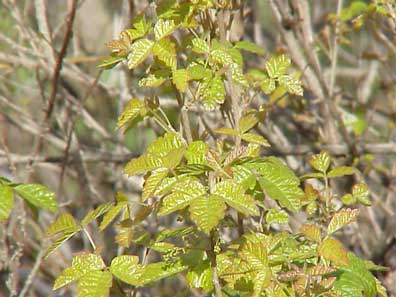
*Western
poison oak (Toxicodendron diversilobum,
Anacardiaceae) This deciduous perennial has
highly variable growth habits: vine, ground
cover, shrub. In chaparral it usually grows
as an erect shrub. Its compound leaves have
three leaflets. The terminal leaflet ranges
in size from 1 to 13 cm. (1/3 to 5 inches)
long by 1 to 8 cm.(1/3 to 3 inches) wide.
Lateral leaflets may be half as long. Leaves
appear shiny bright green or red in spring
then turn dull green or dusty red in summer.
The leaves are very resinous. They can be
confused with blackberry leaves which also
have three leaflets. However, western poison
oak leaves and branches lack any spiny or
hairy projections, and the leaflets tend to
have more rounded tips. The tiny yellowish
green flowers occur in racemose panicles from
April through May. These are followed by 11/2-
to 6-mm. (up to 1/4-inch) creamy white to
brownish berry-like fruits (drupes) which
are an important food for wildlife. Western
poison oak is indifferent to serpentinitic
soils. It occurs in canyons and on slopes
in chaparral and woodland communities. TOXIC:
This plant causes severe contact dermatitis.
Toxicodendron
means "poison tree." Diversilobum refers
to the various shapes the leaves take.
Yedra
(or hiedra, ivy) was used by Chumash externally
in cauterization and in the healing of skin
disorders (warts, cancers, persistent sores).
A decoction of its root was used internally
to cure dysentery and diarrhea. Some remedies
said to soothe the effects of poison oak rash
include bathing in a decoction of mugwort
(Artemisia douglasiana), coyote brush
(Baccharis pilularis), or California
coffeeberry (Rhamnus californica).
|
Associated
species include:
|
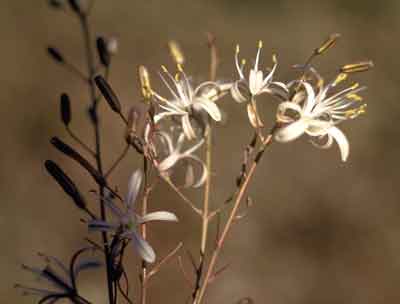
Beatrice F. Howitt
*Soap
plant, amole (Chlorogalum pomeridianum
var. pomeridianum, Liliaceae) Soap plant
is a perennial that grows from a 7- to 15-cm.
(23/4- to 6-inch) white bulb which is covered
by a mat of brown fibers. Its basal, wavy-margined
leaves are 20 to 70 cm. (8 to 28 inches) long
and 6 to 25 mm. (1/4 to 1 inch) wide. The erect
inflorescence ranges in size from 50 to 250
cm. (11/2 to 8 feet) and bears 15 to 25 mm.
(1/2- to 1-inch) flowers that are white. The
flowers open in the evening and close by the
following morning. Following the flower a 5-
to 7-mm. (1/4-inch) stalked capsule with black
seeds develops. Soap plant is indifferent to
serpentinitic soils and can be found in chaparral,
woodlands, and grasslands in Poly Canyon.
Chlorogalum
is Greek for "green milk." Pomeridianum
means "afternoon."
For
Chumash, the bulb of soap plant had a variety
of uses: personal and laundry washing suds,
hide preparation, fishing aid (the bulb was
crushed then mixed into the water of a quiet
pool to stupefy the fish), and rituals. Also,
its fibrous coating was made into hair and cleaning
brushes. The young shoots were roasted and eaten.
|

Prickly,
Phlox-leafed bedstraw (Galium andrewsii,
Rubiaceae) This silvery green perennial grows
low to the ground 5 to 22 cm. (2 to 9 inches)
tall in small tufts or mats. Its 4- to 11-mm.
(1/8- to 1/2-inch) bristly, lanceolate, thickish
leaves occur in whorls of four. The leaves
are sharp to the touch; their tips retain
a single hair-like structure.The inconspicuous
yellowish rotate flowers are followed by tiny
double berries. Prickly bedstraw is a serpentinite-tolerant
plant. It can be found on dry slopes and ridges
in chaparral and open woodland communities,
often beneath the canopy of larger plants.
Galium
comes from the Greek and means "milk" which
some species of Galium are said to
curdle. There was a Dr. Andrews (a physician?)
who collected plants in the mid-1800s after
whom this plant may have been named.
|
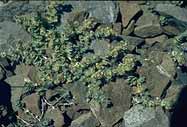
*Climbing
bedstraw (Galium porrigens var.
porrigens, Rubiaceae) Climbing bedstraw
is a 6- to 15-dm. (2- to 5-foot) perennial.
It has slender, softly woody main stems that
are prickly to touch. Its ovate to oblong
leaves grow to 18-mm. (3/4-inch) and occur
in whorls of four. The leaves are pointed,
but not sharp to touch; their tips bear a
single ephemeral hair-like structure. The
minute yellowish to reddish rotate flowers
are followed by equally inconspicuous double
berries. Climbing bedstraw is found in chaparral
and forest communities.
Galium
comes from the Greek and means "milk," which
some species of Galium are said to
curdle. Porrigens means "becoming scaly,"
from porrigo "scurf, dandruff."
|
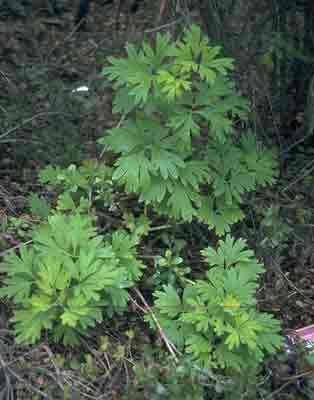
Brother Alfred Brousseau
*California
peony (Paeonia californica, Paeoniaceae)
This is an herbaceous perennial with 35- to
75-cm. (14- to 30-inch) branched stalks. Its
leaves are deeply lobed or divided. Their
upper surfaces are dark green, while their
lower surfaces are pale. California peony
flowers are dark maroon and edged in pink.
Their petals are 15 to 25 mm. (1/2 to 1 inch)
long. The blooms appear from January through
April and are followed by 3- to 4-cm. (1-
to 11/2-inches) dry fruits called follicles.
California peony tends to avoid serpentinitic
soils. It occurs primarily in chaparral and
coastal scrub communities.
Paeon
was the Greek physician to the gods. Californica
means "of California."
Chumash
made Peonia's roots into a tea which
they used to treat menstrual disorders and
neuralgias.
|
|